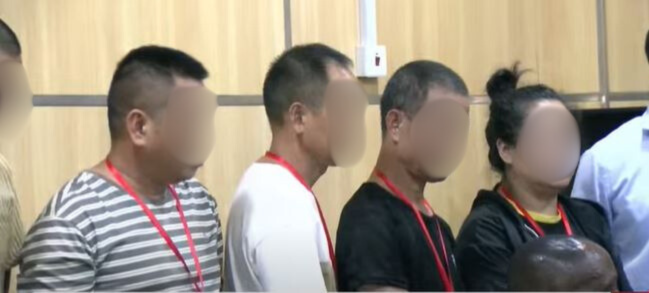Kamunyu & another v Murang'A County Government & another (Environment and Land Appeal E029 of 2024) [2025] KEELC 4885 (KLR) (1 July 2025) (Judgment)
1.The Appellants seek the following orders in the appeal dated 9-7-2024.a.That this appeal be allowed.b.The costs of the appeal be awarded to the Appellant.c.Any other orders that this Court may deem just to grant.
2.The memorandum of appeal contains eleven(11) grounds of appeal as follows.The learned trial magistrate erred in law and in fact by-i.failing to take into account the evidence and the submissions of the Appellants while considering his judgment,ii.failing to appreciate the evidence placed before him on special damages,iii.disregarding the Appellants’ testimonies and documentary evidence before court on ownership of the land and damage caused by the actions of the Respondents and the dates specified together with the year,iv.repetition of (iii) above,v.totally disregarding exhibits produced by the Appellants and more particularly the estimates dated 20-7-2017 that were never disputed,vi.failing to note that the Appellants’ action was based on fresh and new trespass and not premised on enforcing the land,vii.in making a shallow determination on the dates without considering the Appellants’ pleadings and testimonies,viii.failing to consider the magnitude of the dispute herein,ix.failing to consider the submissions by the Appellants,x.failing to consider that Hon. Wachira C M, the magistrate had visited the site and filed a report dated 20-11-2022 on the damage done on the land by the 1st and 2nd Respondents andxi.awarding costs to the Respondent which was not strictly proved in view of the evidence on record.
3.In the judgment dated 26-6-2024, the learned trial magistrate dismissed the Appellants’ suit for the following reasons.i.Failure to specifically plead trespass in the pleadings.ii.Failure to state the date when the cause of action arose.iii.Failure to plead special damages specifically and prove them by producing receipts or other evidence.
4.The facts of the case according to the Appellants are as follows. The first Appellant is the registered owner of L.R. No. Loc. 8/Theri/451. On diverse dates between 30th April and 2nd May, the first Respondent’s agents/servants/employees at the instance of Francis Macharia and Ngure Gatuna trespassed upon the 1st Appellant’s land and uprooted and destroyed the fence. Secondly, the 1st Respondent’s agents widened the path leading to the Appellants’ farms by 3 feet thus causing damage to the Plaintiff’s fence by uprooting it.Regarding the 2nd Appellant, his land is Loc.8/Theri/419 and in addition to widening his road by 3 feet, the first Respondent uprooted 5 trees some of which are Macadamia. Also damaged was the floor of the 2nd Appellant’s slaughter house. It is for these reasons that they filed the suit in the lower court.
5.The facts of the case according to the 1st Respondent are as follows. Firstly, it is true that the road in question was graded. Secondly, the Respondent confined itself to the public road and if any property was damaged, this is because it encroached into the public road. A report by Angeline W. Mwangi dated 14-5-2018 states as follows. Firstly, the land ceased to be agricultural upon the development of an abattoir which called for the expansion of the road to a minimum size of a road which is 9 metres in width and provision of a truncation which is half width of the road as per the Physical Planning Act (Anything less than this becomes a service lane.) Secondly, the building line of the existing building was not observed as per the Physical Planning Act. A set back of at least 1.5 metres was required. Finally the road works were done within the extents of the road. The author of the report is a representative CEM Lands, Housing and Physical Planning.
6.The only submissions on record are those by the Counsel for the 1st Respondent. The Appellant’s Counsel promised to avail a copy but I have not seen it on record. The issues identified by the 1st Respondents counsel in the submissions dated 25-3-2025 are as follows.i.Whether the Appellants pleaded and proved encroachment into their land and conversion of part of their parcel of land to public land.ii.If the Respondent was justified to expand a road of access to cover the Appellants’ parcels of land without compliance with the law.iii.Whether the Appellant pleaded and proved special damages.iv.If the Respondent was liable for the encroachment, loss and damage suffered by the Appellants.v.Whether the appeal has merits.vi.Whether the Appellants are entitled to the orders as to costs.
7.I have carefully considered the record of appeal including the proceedings in the lower court, the grounds of appeal, the written submissions by the 1st Respondent’s counsel and the issues raised therein as well as the law cited. To balance the judgment, I will consider the Appellant’s grounds of appeal as their issues. I make the following findings.
8.On the first of the Appellants’ grounds of appeal, I find that the learned trial magistrate did not err. The evidence adduced by the Appellants as to the encroachment on their land fell short of the evidence required to prove the case to the required standard. The most critical evidence required in this case by the Appellants was that of a surveyor. Such evidence would have shown the size of the Appellants land, its dimensions, the extent of the road and proof that the road went beyond its prescribed size into the Appellants’ land. Had the Appellants filed such evidence and called an expert witness, then they would have stood a chance of proving their case to the standard required by law.
9.Without first proving that the damage and trespass occurred on the Appellants’ land, even if the special damages had been pleaded and proved to have occurred, they still could not be awarded. Proof that the land belonged to the Appellants was the first barrier. Failure to cross it meant that nothing else could succeed. I therefore find that the learned trial magistrate did not err. He was spot on as regards to specifically pleading special damages before proving them as per the case of Hahn vs Singh Civil Appeal No. 42 of 1983 [1985] IKLR 716.
10.It was not disputed that the Appellants owned their respective parcels of land. What was disputed was that there was encroachment on that land. Even if the trial magistrate had said that the Appellants own their respective parcels, that would not have sufficed. What would have been of use was proof that the trees and other property was growing on the Appellants land. This is what they failed to prove for failure to call the Surveyor.
11.Considering the exhibits would not have helped the Appellants’ cause without the crucial question of trespass being proved by the Appellants. I find no error on the part of the trial magistrate.
12.While it is true that the learned trial magistrate said that he could not know if the Appellants suit was affected by limitation, I agree with him entirely. The Appellants failed to mention the year when the cause of action arose in the plaint. Even though they mentioned it in the reply to the defence, it has rather halfheartedly. It should have been in the main pleadings. It is my finding that it is immaterial whether the Appellants had stated the year or not. Without proof that the property damaged was on their land and not on the public road, nothing else would have saved their case. This finding covers the seventh ground of appeal.
13.Looking at the 8th ground of appeal, I find that the magnitude of this dispute was not big. According to the valuation report dated 17-10-2022 the value of the land taken was Kshs 63,000/= and the value of other loses was Kshs 242,640/=. The report of the second parcel put the value of the damage at Kshs 1,072,520. The reports by the soil and water engineer put the value at Kshs. 224,000/= and Kshs. 616,030/= respectively. This means that the claim could have been handled by a Resident Magistrate. This is not to mean that the court would ignore it if it is a small claim. All claims big and small are proved in the same way and the standard of proof required by the law is the same. As I have said repeatedly, the biggest problem with the Appellants’ case was failure to prove that the property damaged was on their land.
14.No matter how good the written submissions are, if the case is not proved by evidence, the submissions will not help. Cases are won on cogent, credible, relevant and admissible evidence but never on submissions.
15.The evidence of the site visit by Hon. Wachira, Chief Magistrate would not help the Appellants’ cause unless there was a surveyor who assisted the court during the site visit to point out on the extent of the road vis a vis the Appellants’ land and proof that there was encroachment. There is nothing on record to show that there was any surveyor during the site visit.
16.The Respondents were definitely entitled to costs. It is the Appellants who filed the suits in the lower court. Their suits were dismissed. Costs follow the event as per Section 27 of the Civil Procedure Act. The Respondent incurred costs in defending the suit and attending court. Such costs would not have been incurred by the Respondents if the Appellants had not filed the suits. He who makes his bed must lie in it. Choices have consequences. The Appellants chose to file the suits. They lost the suits. They must pay the costs to the Respondents. The trial magistrate was right in awarding costs to the Respondents.
17.Having considered the Appellants issues, I think it would be superfluous to consider the Respondents’ issues. I have already necessarily considered the Respondents’ submissions in considering those by the Appellants.
18.For the reasons given above, I find no merit at all in the appeals which I dismiss with costs to the Respondents.
It is so ordered.
DATED, SIGNED AND DELIVERED VIRTUALLY AT MURANG’A THIS 1ST DAY OF JULY, 2025.M.N. GICHERUJUDGE.Delivered online in the presence of; -Court Assistant – Mwangi NjonjoAppellants’ Counsel – Mr. OwitiRespondent’s Counsel – Mr. Macharia holding brief












